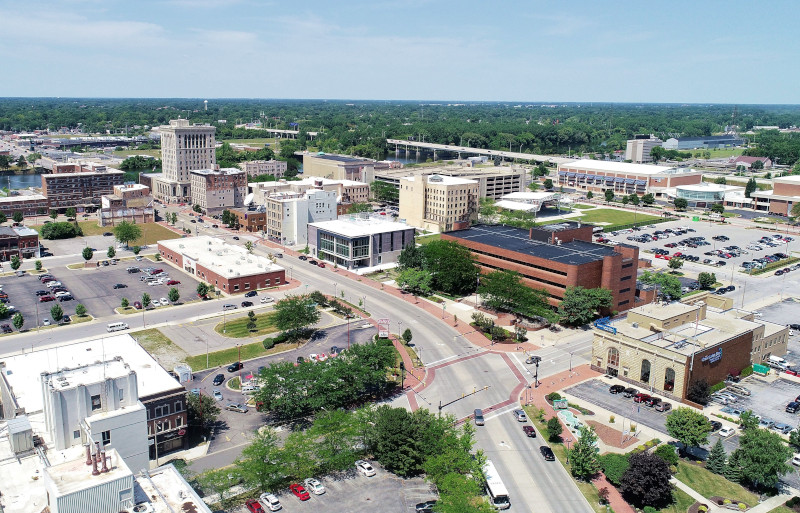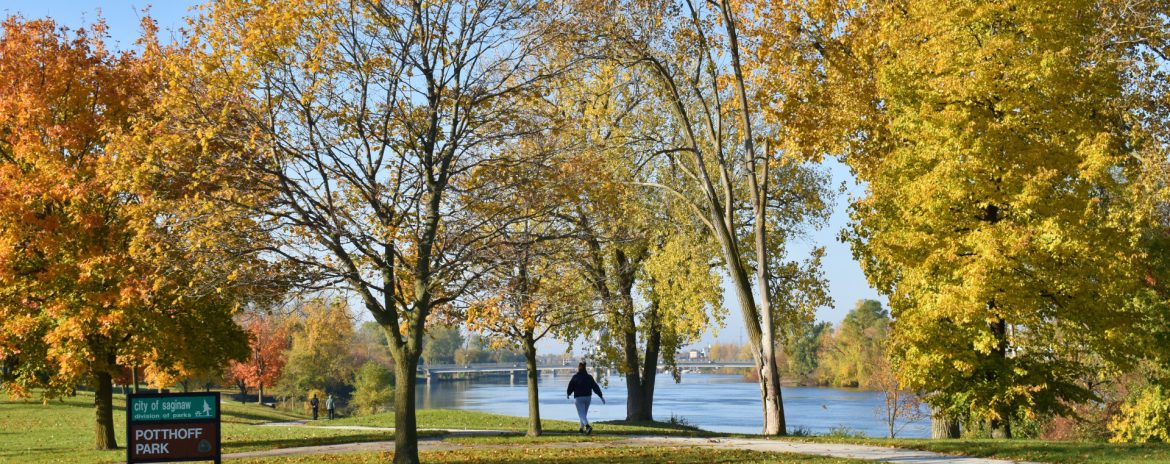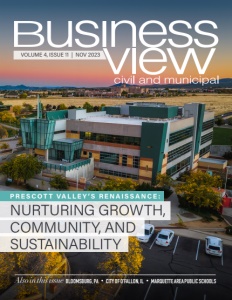Saginaw, Michigan
Building Opportunity Well into the Future
A rustbelt city in Michigan is on the rebound and firmly looking forward
A proud city and one built on manufacturing, Saginaw, Michigan has a lot to be excited about these days. Having been struck by the loss of manufacturing jobs in the past, the city is embracing and supporting its citizens while firmly looking to a future that involves growth and renewal.
Two centuries of history
Located in central eastern Michigan, the site of what later became the City of Saginaw was originally inhabited by the Anishinaabe and Ojibwe (Chippewa) peoples. In 1816, French trapper, Louis Campau, established a trading post on the west bank of the Saginaw River, which flowed northward into Saginaw Bay and Lake Huron.
For much of the late 19th century, the town was a central hub of Michigan’s lumber industry – it received logs from the state’s abundant pine forests via the same river that also powered its sawmills; its expanding port serviced the Great Lake shipping vessels that transported the milled lumber to a growing nation and beyond; and its many railroads lines carried goods and passengers to and from the city in every direction.
By the early 20th century, the lumber industry had declined, but automobile production proliferated throughout the Wolverine State, and foundries and manufacturing facilities were established in Saginaw to supply General Motors and other car makers with metal, chemicals, and glass, as well as various manufactured parts and assemblies — manual transmissions, steering gearboxes, and pumps, etc.
During World War II, the city’s industrial complex turned its efforts to the production of munitions, ordnance, and military vehicles. Throughout the 1940s and ‘50s, Saginaw’s population grew by 20 percent. Twenty years later, though, it was time to leave.
The present into the future
Today, Saginaw is a city on the rebound, always reaching for the American Dream, regardless of how it may have been denied from time to time due to detours and roadblocks on its ongoing economic journey.
City Manager, Tim Morales, believes that Saginaw’s renaissance will be powered by the medical industry, currently its top employer, and anchored by its three major hospitals: the Aleda E. Lutz Veterans Affairs Medical Center, Covenant Medical Center, and Ascension Saint Mary’s of Michigan.
The city’s medical educational complex also includes the Central Michigan University (CMU) College of Medicine“We’re focusing now on additional downtown development, specifically on medical services because Saginaw is a medical hub for northern Michigan,” Morales explains. “So, we’re trying to increase our capacity there to provide additional mental health assistance and also basic medical care needs.”
“Our other focus is education. We have a lot of post-secondary educational facilities in the area, and recently, we’ve had additional development downtown for Delta College, which is our regional community college. We have offices and classrooms for Saginaw Valley State University downtown and we have two years of medical school for Central Michigan University.”
“We have a real need in northern Michigan for additional medical practitioners, so the goal of Central’s medical school is to train people and try to keep them in the region,” he adds.
Morales hopes that the city’s medical education sector will help make it attractive for other types of medical companies, such as pharmaceuticals, to move in, but also that it will attract more people to live downtown, which would naturally spur economic development in the retail and service sectors.”
“The more people we bring downtown, particularly to live,we’ll bring more small businesses and jobs that people in our community might need and be able to fill,” he states. “So that’s a big focus.”

City Council
The city’s assets
Cassi Zimmerman, Saginaw’s Director of Planning and Economic Development, stresses the city’s many attractions and amenities that, in addition to any new employment opportunities, will help entice people to repopulate its traditional neighborhoods as well as its downtown locales.
“Besides attracting businesses and working on our city as an employment center, another aspect that we’ve emphasized in the last five to ten years concerns our quality of life. We want to attract people to not only work here but to live here,” she relays.
“The city offers so much and caters to everyone’s interests. We have amazing amenities including a local orchestra, choral society, children’s zoo, community theaters and several museums.”
Morales agrees, citing the Dow Event Center, the historic Temple Theatre, the SVRC Marketplace, and the city’s many parks, bars, and restaurants as important assets. The Dow Event Center is an indoor arena that currently houses the Ontario Hockey League’s Saginaw Spirit.
The center has a capacity of 7,600 people for concerts (without the ice), and 5,500 for hockey games. The Temple Theatre was built by the Elf Khurafeh Shriners and opened in 1927 and it was restored in late 2002 and then reopened under new owners.
“The SVRC Marketplace is a redevelopment of the former Saginaw News Building into a 100,000 sq. ft. mixed-use facility in downtown Saginaw and home to the city’s famed Farmers’ Market which operates from Memorial Day to late October. “Saginaw has so many amenities that are available in the much larger cities,” he states.
Another attraction, according to Zimmerman, is Saginaw’s varied residential offerings.
“We have newly developed condos right off the Saginaw River that were initially occupied in 2017, so they are still pretty new,” she notes.
“One of the incentives for that project was a ‘Renaissance Zone’ that allowed us to have a little more expensive housing developed in the city.” (The Renaissance Zone program includes a waiver of many city and county taxes for property owners within the district.)
“We also have an affordable housing market,” she adds. “We have a large amount of single-family homes in the city, mixed in with apartment buildings. The middle type of housing, like townhomes, is what we’re still working on. We’ve had a lot of developer interest in additional housing. We’re starting to see it transform the community and we’re excited to see over the next ten to fifteen years how different Saginaw will look.”
Ongoing projects
Meanwhile, as is the case with any city, Saginaw has an ongoing list of infrastructure projects under construction. “We’re currently switching all lead service water lines from lead to copper throughout the city,” Zimmerman reports.
“That’s a multi-year project that started a couple of years back; we’re always working on water and sewer. We do have a few state highways that run through the city, one of them being Washington Avenue, or M-13, a main thoroughfare that goes right through our downtown. We’ve been working with the Michigan Department of Transportation, especially with some of these new medical projects that are in the hopper, to try and do some traffic calming on those roads.”
“We did get a pretty large allocation from the state totaling about $33 million for some infrastructure upgrades like burying high voltage utility lines and preparing a big stretch of Washington Avenue for development. That’s going to be transformational over the next few years,” she further illustrates.
Saginaw is also working on its portion of the Iron Belle Trail, a 2,000-mile bicycling and hiking route that crosses route 48 different Michigan communities from the far western tip of the Upper Peninsula to Belle Island in Detroit.
“We’ve been working to make sure that every portion of that trail is separated for cyclists and pedestrians,” Zimmerman says. “And we’re very close to getting that done. We have just one more link that we have grant applications out for. If those are accepted, we will have 100 percent separated trails throughout the city.”
 The Memorial Cup
The Memorial Cup
Perhaps the most positive and powerful event that may soon help Saginaw achieve many of its regenerative goals is its recent designation as the host city for the 2024 Memorial Cup, the 104th iteration of the Canadian Hockey League’s four-team, round-robin, ice hockey tournament that will be held at the Dow Event Center, in late May and early June of next year.
“Once we found out that we had the Memorial Cup in 2024, we formed an internal committee with members from engineering, public services, traffic and planning, code inspection, and the fire marshal,” Zimmerman says. “It meets regularly to discuss things that we need to tackle in the area. We talked about buildings that maybe weren’t meeting building code that we need to put more pressure on.”
“We’re talking about different landscaping elements like decorative fencing, more signage, as well as a few murals going in around that area. We’re focused on where visitors may wander and making sure those areas are in top shape. One area is an alleyway that runs adjacent to our outdoor event park, another is a side street that is under redevelopment currently to be transformed in a food truck alley. We have well over $1 million of city projects that we’re working on. Some have been completed, some are underway, and some will be done by the end of this year or the beginning of next year. “
“We also have a project that was started by the Riverfront Development Commission that will upgrade one of our water access points right in the downtown with some of the American Rescue Plan Act money that came as COVID relief to the city,” she continues.
“The city council designated $200,000 to make sure that project could be moved up and completed before the Memorial Cup. That will be creating a riverfront gateway – right on the Iron Belle Trail and our riverfront walk, and right by the SVRC Marketplace.”
“On the business side, we’re going to pull together meetings between the city, businesses, and the Memorial Cup folks, as well as our transit organization, to make sure that everyone will be fully aware of what’s going to be happening and when. This is expected to bring about $25 million in economic activity into the region for those 10-13 days of the tournament. Many organizations are collaborating for this event and we want to make sure all businesses are aware of the opportunities and how they can take full advantage.”
“I’m hoping that the Memorial Cup will be organized enough so that people who come will know exactly what they can do and they’ll be busy, even when they’re not at a game. We want to make sure that the city is capitalizing on this as much as we can.”
The Mayor’s vision
Mayor Brenda F. Moore is a lifelong resident of Saginaw and has been on the City Council since 2013. Her vision for her city is simple and succinct.
“We are a city that wants to grow and prosper,” she says. “We want to clean up the city, build our city, and continue to make it better. We’ve got a lot of innovative things that we’re working on right now. And I want the world to know that Saginaw is a welcoming community. We support everyone.”
With all of the exciting changes currently taking place in Saginaw, Michigan the future looks promising. Prepared to meet growth while standing firmly in the tradition of its past, the city is ripe for renewal.
AT A GLANCE
Saginaw, Michigan
WHAT: A city of 45,000
WHERE: On the Saginaw River in central-eastern Michigan
WEBSITE: www.saginaw-mi.com
PREFERRED VENDORS
Saginaw Intermediate School District – www.sisd.cc
Saginaw Intermediate School District (ISD) is an educational service agency that provides effective and innovative leadership, services, resources, and programs throughout Saginaw County. Saginaw ISD provides career and technical education, early childhood, finance, human resources, instruction, pupil accounting, special education, technology, and transportation services. In addition, Saginaw ISD operates multiple educational programs to meet the unique needs of students ages birth to 26 across Saginaw County, including Hartley Outdoor Education Center, Head Start/Early Head Start and Great Start to Readiness Programs, Great Lakes Bay Early College, Saginaw County Juvenile Detention Center School, and Special Education Center Programs.
Saginaw Valley State University – www.svsu.edu
Saginaw Valley State University has a distinguished history of partnering with its community, earning the Carnegie Foundation’s designation as a community-engaged university. SVSU recently partnered with Saginaw Public Schools on a program to educate certified teachers, as well as major hospitals Covenant HealthCare and Ascension St. Mary’s to increase access for health care professionals to complete degrees.






